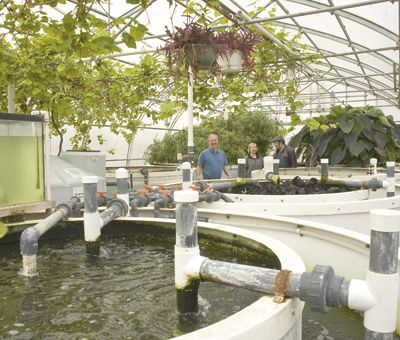Green-Eyed Muenster

By Christine Hyatt
As we consumers enjoy our fancy cheese, we focus on nuance, flavor, aroma, texture, a true tasting experience. What we rarely get to glimpse is the behind-the-scenes balance between principle and profit that goes into its production.
For many cheesemakers, creating sustainable businesses that tread gently on the earth is a top priority. Producing cheese is a resource-intensive process; energy to power the plant and keep aging and storage facilities cool, water for heating vats during production, and later for sanitizing equipment, account for the majority of a creamery’s energy usage.
In previous columns, we have covered the evolving “green” cheese scene here in Oregon. This month, we’ll cast a wider net, highlighting some innovative green producers in Wisconsin but not before a shout out to some of the latest ecologically friendly developments in our state.
First, Rogue Creamery steadily climbs the ranks of Best Oregon Green Companies, reaching no. 22 on this year’s list compiled by Oregon Business Journal.
Late last year, co-owners David Gremmels and Cary Bryant realized an enduring dream of installing a photovoltaic array on the roof of their blue cheese facility. The dark days of winter provided glimmers of the new system’s impact. Last month, it outperformed expectations, powering creamery operations and producing extra energy, which they sold back to the grid. A doubly green endeavor, indeed.
Sustainability is a value held dear by our Oregon cheesemakers, and this standard is echoed in other regions as well. One of the most unique green initiatives in the cheese world is the “Living Machine” at Cedar Grove Cheese in Plain, Wisc., a family-owned creamery founded in 1878.
Creamery owner Bob Wills was not “born into cheese.” Rather, the lawyer-turned-cheesemaker married into it. One of only 44 Master Cheesemakers — a big deal in Wisconsin — he has completed an official three-year program of study open only to cheesemakers with more than a decade of experience. Today, Cedar Grove produces a range of traditional and specialty cheeses, using rBGH-free milk from 20 Wisconsin dairies.
Wills’ love for the craft of cheesemaking is equaled by his commitment to run a sustainable, green business. Inspired by values promoted by former Wisconsin Governor and U.S. Senator Gaylord Nelson, who founded Earth Day in 1970, Wills came into the business with a commitment to earth-friendly practices.
“Cheese factories run into problems with water,” he said. The traditional ways water has been handled for 130 years have had to change. The problem stems from wastewater from the plant, which have high levels of phosphorous and chloride and other residuals that have become more highly regulated over the years.
In the past, the company had used land spreading, which Wills describes as a very expensive practice of returning to the soil some of the organic agricultural materials. One day on a plant tour, a professor from a local college told him about a new technology employed at his college, a complete ecosystem that filtered and cleaned water.
Wills was intrigued and contacted the Living Technologies Company, which had installed projects for Ben & Jerry’s and others but had never worked with a cheese plant. There was no guarantee it would succeed. With a portion of funding through the state of Wisconsin, the “Living Machine” was operational by 1999.
The system processes about 8,000 gallons of water a day through a purification facility behind the cheese plant. Over the course of three to four days, water is filtered using microbes, tropical plants, fish and snails before being released into nearby Honey Creek.
The process removes 99 percent of the biological oxygen demand, 98 percent of the suspended solids, 93 percent of total nitrogen and 57 percent of phosphorus. The process substantially reduces wastewater expenses and generates fertile soil used to grow tomatoes, peppers and other vegetables onsite.
Recently, Wills broke ground on his latest endeavor, Clock Tower Creamery in Milwaukee. The venture will maintain onsite production in an urban setting and will include a retail store. The new plant will be powered using geothermal heating and wind-powered electricity. The facility also will sport a green roof and use steam from a local generating plant.
“None of the things I’ve done have been bad business decisions,” Wills noted. “All the other projects have saved or made us money. In Milwaukee, green energy is more expensive and could be considered a sacrifice if looked at narrowly. I could get energy cheaper, but why would I?”
Whether it’s Wills in Wisconsin or the folks down at Rogue, “green” cheese production is a fascinating and worthy endeavor.
Christine Hyatt is a food writer and videographer. She currently serves as President of the American Cheese Society. Visit www.cheesechickchat.com for more cheesy adventures!
DRIED APRICOT AND PISTACHION CHUTNEY
Recipe by Christine Hyatt
A colorful and delicious pairing for soft, mild cheeses like Havarti and Camembert, this sweet and salty chutney gets a dash of complexity from bourbon.
INGREDIENTS
1 tablespoon butter
1 cup dried apricots, coarsely chopped
2 teaspoons honey
¼ teaspoon cinnamon
1/8 teaspoon salt (omit if using salted pistachios)
2 tablespoons bourbon whiskey
1/3 cup pistachios, chopped
DIRECTIONS
1. In a large skillet, heat butter over medium-high heat. Add apricots, and stir until coated with butter. Add honey, cinnamon and salt. Sauté for 1 minute, stirring constantly. 2. Add bourbon and pistachios. Continue stirring for up to 2 minutes or until bourbon evaporates. Remove from heat and cool slightly.
SERVING SUGGESTION
Press chutney into an attractively shaped 1 cup measure and invert onto plate. The chutney will retain the shape and can be easily sliced with a knife.










